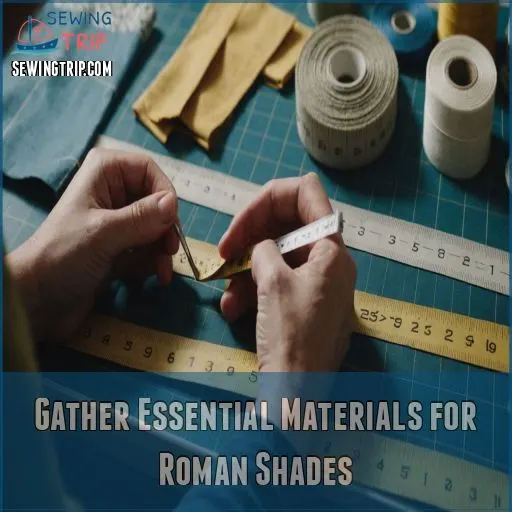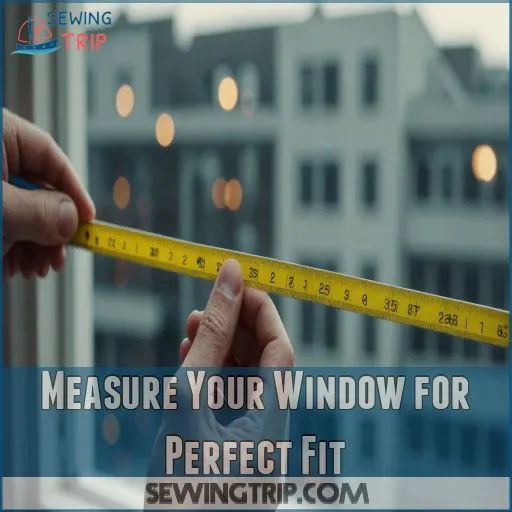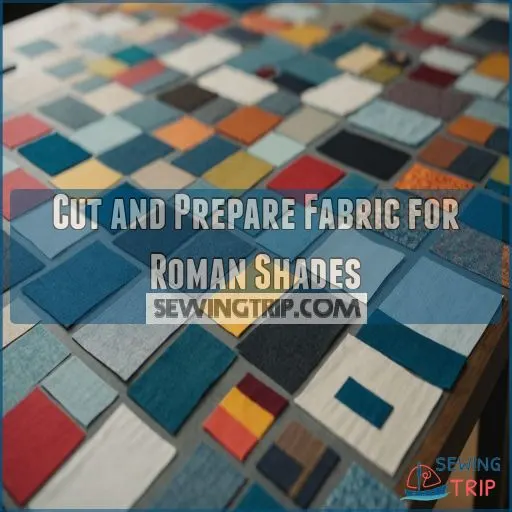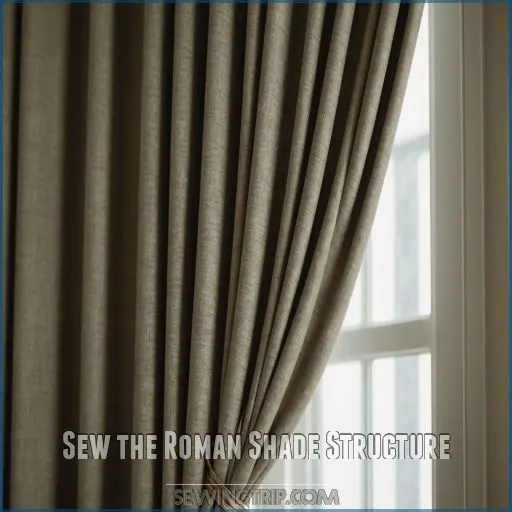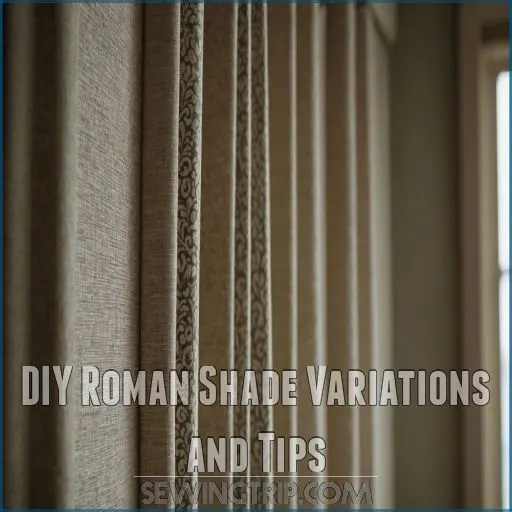This site is supported by our readers. We may earn a commission, at no cost to you, if you purchase through links.
 Ready to transform your windows? Making Roman shades isn’t just a DIY project; it’s your ticket to custom, stylish decor.
Ready to transform your windows? Making Roman shades isn’t just a DIY project; it’s your ticket to custom, stylish decor.
You’ll need fabric, lining, dowel rods, and some basic hardware. Measure your window precisely, then cut and prepare your materials. Sew the structure, adding dowel pockets and rings for the cords.
Mount your creation and thread the cords – voila! You’ve mastered the art of Roman shades. It’s like origami for your windows, but way more practical.
And here’s a pro tip: using mini blinds as a base can simplify the process. Stick around to uncover more clever tricks that’ll have you shading like a pro in no time.
Table Of Contents
Key Takeaways
- You’ll transform your windows into stylish focal points with DIY Roman shades – it’s like origami for your home, but way more practical and budget-friendly.
- Measuring is your secret weapon – nail those dimensions and you’re halfway to achieving shade perfection. Remember, windows can be as crooked as a politician’s smile, so double-check everything.
- Threading cords through rings is an art form – master it and you’ll have shades that rise and fall smoother than a jazz saxophonist’s solo.
- Don’t be afraid to jazz up your creation with trims and embellishments – it’s your chance to let your inner designer shine and make your neighbors peek through their (less fabulous) curtains with envy.
Gather Essential Materials for Roman Shades
You’re about to start a DIY adventure that’ll transform your windows into stylish focal points.
Before you start, let’s round up the essentials you’ll need to create your own Roman shades.
From fabric that’ll make your neighbors peek through their (less fabulous) curtains to the tools that’ll turn you into a home decor wizard.
This project will require some key elements, but with the right materials, you’ll be on your way to creating stylish focal points that will elevate your home’s aesthetic.
Fabric Selection and Measurement
Ready to start your Roman shade adventure? Let’s kick things off with the fabric-selecting fun!
You’ll want a mid-weight cotton or linen that’s as pliable as your DIY spirit. Consider pattern matching and translucency – nobody wants a see-through shade disaster!
Don’t forget lining choices; they’re your secret weapon for light.
Your window’s about to get a stylish makeover.
Tools and Hardware
Now that you’ve chosen your fabric, let’s gear up for the DIY adventure ahead!
You’ll need a few trusty sidekicks to bring your roman shade vision to life!
Here’s your toolkit for success:
- Dowel rods: Your shade’s backbone
- Mounting brackets: The unsung heroes of stability
- Roman shade hardware: Pulleys and cord locks for smooth sailing
- Staple gun: Your new best friend
- Screwdriver: For those tight spots
Remember, with the right tools, you’re the master of your window’s fate!
Lining Options
Let’s dress up those windows! You’ve got your tools, but what about the lining? It’s like choosing the perfect undershirt – it makes all the difference.
Light-filtering linings let you bask in a soft glow, while blackout options turn your room into a cozy cave.
For a touch of luxury, faux silk or taffeta can add that ‘je ne sais quoi’ to your Roman shade folds.
Cord and Ring Systems
From the ground up, you’ll need to master the cord and ring system for your DIY roman shades.
Choose plastic rings about 1" from each edge, spaced 10" apart. For cord material, opt for durable Dacron Leech Line.
Remember, ring size and placement affect system tension, so don’t skimp on quality. You’re not just making window dressings; you’re crafting your sanctuary’s finishing touch!
Measure Your Window for Perfect Fit
You’ve got your materials ready, but hold your horses. Before you start cutting fabric, you need to nail those measurements. Trust me, nothing’s worse than a wonky shade that looks like it’s had one too many.
For a child-safe option, consider mounting your shades high to keep cords and strings out of reach. Child Safety is essential when deciding on the length of your roman shades.
Grab your trusty measuring tape and let’s get cracking. For inside mounts, measure the width at three points – top, middle, and bottom. Use the narrowest measurement to guarantee a snug fit. Height-wise, measure from the top inside edge to the sill at left, center, and right. Go with the longest measurement here.
Outside mounts? You’ve got more wiggle room. Add a few inches to each side for that ‘bigger window’ illusion. Remember, windows can be as crooked as a politician’s smile, so double-check everything.
With precise measurements, you’ll be one step closer to shade perfection!
Cut and Prepare Fabric for Roman Shades
Ready to turn your fabric into a stunning Roman shade?
Let’s tackle the important step of cutting and prepping your materials, where precision meets creativity.
To create a window treatment that’ll make your neighbors green with envy, for a window treatment that’s both beautiful and functional.
Calculating Fabric Dimensions
The fabric math dance begins! Time to transform those window measurements into fabric dimensions. Don’t worry, it’s not rocket science—just a bit of crafty calculation.
Here’s your fabric formula cheat sheet:
- Add 3 inches to your shade width for edge finishing
- Include top and bottom hems in your height calculations
- Factor in pattern repeats for a seamless look
Remember, measuring twice means you’ll only need to cut once. Now, let’s conquer those calculations!
Cutting Main Fabric and Lining
Now that you’ve got your measurements, it’s time to wield those scissors! Let’s cut your fabric like a pro, ensuring your roman shades fit like a glove.
Remember, precision is key – a little extra care now means fewer headaches later.
Here’s a quick guide to help you nail those cuts:
| Fabric Type | Width Calculation | Length Calculation |
|---|---|---|
| Main Fabric | Desired + 4" | Desired + 12" |
| Lining | Desired – 3" | Desired + 6" |
| Outdoor | Same as Main | Add for UV resistance |
| Blackout | Same as Lining | Consider light gaps |
| Decorative | Add for pattern | Match repeat carefully |
Attaching Lining to Main Fabric
With your fabric cut, it’s time to play matchmaker! Lay your main fabric face-down and place the lining on top, right side up. Pin the edges and sew along the sides and top, leaving the bottom open for a secret escape route.
It’s like tucking your shade into a cozy blanket.
Here’s your lining lowdown:
- Choose lightweight cotton for light fabrics
- Opt for blackout lining in bedrooms
- Use dark lining for deep-colored fabrics
- Make sure the lining is inset by ½" on sides and bottom
Creating Dowel Pockets
You’ve conquered the lining, now let’s tackle those dowel pockets. When sewing seams for your Roman shade, consider the type of dowel you’ll be using, as this will affect the size of your pockets.
Mark horizontal lines every 8-12 inches across your fabric for perfect pocket placement, keeping in mind that you’ll want to add two inches extra if you want your shade to be wider than necessary using final dimensions.
Cut 2-inch strips from leftover lining fabric, fold them in half, and press. Sew the edges together, creating snug homes for your dowels.
Remember, these pockets are like secret agents – they work behind the scenes to give your shade that polished, professional look!
Sew the Roman Shade Structure
Ready to bring your Roman shade to life? Let’s stitch this beauty together, transforming your fabric into a functional window masterpiece that’ll have your neighbors peeking in with envy.
Stitching Side Seams
Let’s tackle those side seams and bring your Roman shade to life! Thread your sewing machine with matching thread and get ready to stitch, following the steps for threading a zig zag sewing machine
. Remember, precision is key for that polished look.
- Pin fabric edges together, right sides facing
- Sew a straight stitch 1/2 inch from the edge, utilizing a seam finishes using straight stitch sewing machine
- Press seams open with a hot iron
- Topstitch for added style and durability
Pro tip: Use a longer stitch length for fabrics that fray easily. You’ve got this – soon you’ll be basking in the glow of your custom window treatment!
Forming Bottom Hem
Time to give your shade a polished finish! Fold the bottom edge up 1/4 inch, then another 1 1/4 inches to create a neat hem.
Iron it crisp – no wrinkles allowed in this refined look! Secure with pins if needed, then sew a straight line close to the edge.
This hemming technique forms a sleek rod pocket, perfect for adding weight and structure to your chic window treatment.
Adding Dowel Casings
Now that your bottom hem’s all set, it’s time to give your shade some backbone!
Dowel casings are the secret sauce for crisp, clean folds.
Measure and mark 8-inch intervals up your fabric, then create 1.5-inch wide pockets.
It’s like giving your shade a series of mini-facelift lines!
Stitch these casings with precision – they’re the scaffolding that’ll make your Roman shade stand tall and proud, with crisp, clean folds.
Attaching Rings for Cords
With your dowel casings in place, it’s time to give your shade some lift!
Grab those trusty rings – they’re the unsung heroes of your Roman shade operation.
Space them evenly along the back, about 6 inches apart (Source).
Sew each ring securely, ensuring they’re aligned vertically for smooth cord routing.
Remember, proper ring placement is key to achieving that perfect, effortless fold when you raise your shade, and it will result in a smooth cord routing.
Install Hardware and Mount Roman Shades
You’re in the home stretch of your Roman shade project, and it’s time to make it shine.
Get ready to flex those DIY muscles as we tackle the hardware installation and mounting process, transforming your crafty creation into a stunning window treatment that’ll make your neighbors green with envy.
The DIY muscles was replaced with a better phrase for skimming.
Securing Mounting Board
Securing your mounting board is like laying the foundation for your window masterpiece. You’re in control, so let’s nail this step!
Here’s your foolproof guide:
- Mark your territory: Position the board and pencil in your bracket spots.
- Drill pilot holes: Avoid the "oops" of splitting wood.
- Choose your weapons: Wall anchors for drywall, screws for studs.
- Fasten with gusto: Tighten those screws until they’re snug as a bug.
Attaching Shade to Board
You’ve got your mounting board ready, so let’s get your shade up and running!
Grab your staple gun and position the shade’s top edge along the board. Make sure it’s centered and nobody wants a wonky window treatment!
Secure it with staples every few inches, working your way across. For a polished look, consider wrapping the board with leftover fabric before attaching the shade.
You’re one step closer to window wizardry!
Threading Cords Through Rings
Like threading a needle, mastering cord placement is key to your Roman shade’s success.
Let’s get into the art of threading cords through rings:
- Choose the right ring size for your cord thickness
- Knot cords securely to bottom rings, leaving room for adjustments
- Run cords up through rings, creating a smooth path for easy lifting
- Maintain even cord tension to make sure your shade rises and falls like a pro
Remember, patience is your best friend here. You’ve got this!
Installing Cleats for Cord Management
Now that you’ve threaded the cords, it’s time to tame those dangling strings.
Let’s talk cleats – your new best friends in cord management.
Pick a spot that’s out of reach for tiny hands but easy for you to access.
Install two cleats, one above the other, about 6 to 12 inches apart.
Wrap the cords in a figure-eight pattern for a tidy, safe finish.
You’re one step closer to shade perfection!
DIY Roman Shade Variations and Tips
You’ve mastered the basics, now let’s spice up your Roman shade game with some creative twists.
From faux shades that hide ugly blinds to no-sew options for the needle-phobic, these variations will have you whipping up custom window treatments faster than you can say "interior designer.
Faux Roman Shade Method
Want to jazz up your windows without breaking the bank? Try the faux Roman shade method! This budget-friendly option lets you tap into your inner designer without the hassle of cords and pulleys.
Imagine this stylish DIY project:
- Selecting a fabulous fabric that makes your heart sing
- Measuring and cutting with the precision of a master tailor
- Creating elegant folds that catch the light just right
- Mounting your masterpiece with pride and a touch of ingenuity
Let’s turn those bare windows into showstoppers!
Using Mini Blinds as Base
Transforming those dusty mini blinds into chic Roman shades is like giving your windows a makeover on a budget. You’ll be the master of upcycling, turning trash into treasure.
Let’s break down this mini blind hack into bite-sized steps:
| Step | Action | Pro Tip |
|---|---|---|
| 1. Prep | Remove slats, keep cords | Save slats for structure |
| 2. Measure | Mark fabric every 7 inches | Use chalk for easy removal |
| 3. Attach | Glue fabric to blind structure | Let dry overnight for durability |
| 4. Finish | Hem sides and bottom | Add lining for extra polish |
This DIY project‘s a breeze, and you’ll feel like a window treatment wizard when you’re done.
No-Sew Roman Shade Options
Your window’s transformation awaits with these no-sew Roman shade hacks!
Ditch the needle and thread for budget-friendly options like iron-on hem tape or fabric glue.
Choose a fabric that speaks to you – maybe a fabric that complements your room’s color scheme.
With just tension rods and your chosen fabric, you’ll be strutting your DIY prowess in no time.
It’s easier than getting dinner on the table!
Customizing With Trims and Embellishments
Anyone can elevate their DIY Roman shades from simple to stunning with the right embellishments. Let’s jazz up those window treatments and make them truly yours!
Here are some eye-catching ideas to get your creative juices flowing:
- Sew on delicate embroidered trims for a touch of elegance
- Add funky tassels or pom-poms for a playful vibe
- Incorporate decorative hardware accents like crystal finials
- Attach ribbon borders for a crisp, clean look
- Experiment with fabric paint for unique patterns
Remember, the possibilities are endless when it comes to customizing your shades!
Frequently Asked Questions (FAQs)
Are Roman shades easy to make?
Like a DIY Michelangelo, you’ll find crafting Roman shades surprisingly achievable.
With basic sewing skills and patience, you’ll conquer this stylish window treatment, and following books and tutorials on sewing can help you gain the confidence you need to make it happen
.
It’s a fun window treatment that’ll give you control over your decor and save money.
How much material does it take to make a Roman shade?
Calculating fabric for Roman shades isn’t rocket science.
You’ll need the shade’s width plus 4 inches, and its length plus extras for hems and dowels.
A handy formula: (Height + Hems) x ((Width + Side Hem) / Fabric Width) , which can help with the fabric calculation.
How to make a roman blind without lining?
Ready to streamline your DIY project?
Skip the lining and create a chic roman blind.
Measure your window, cut fabric to size, sew dowel pockets, attach rings, mount.
You’ll have a stylish shade in no time.
How to make faux Roman shades with dowels?
Transform your windows with faux Roman shades using dowels.
Measure, cut fabric, create dowel pockets every 8 inches, and attach rings.
Thread string through for that classic folded look.
It’s easier than you think!
How do I choose the best fabric for Roman shades?
Ever wondered why your Roman shades don’t quite hit the mark?
Choose linen or cotton for their versatility and durability.
Consider your room’s style, desired light filtration, and budget.
You’ll nail that perfect blend of function and flair.
Can I make Roman shades without sewing?
No-sew Roman shades are a breeze.
Grab some fabric, tension rods, and iron-on hem tape for a seamless finish with perfect hem tape
.
It’s like magic – you’ll have chic window treatments in less time than it takes to order takeout.
Whats the ideal spacing between folds on Roman shades?
Like a perfectly tuned piano, Roman shades sing when their folds harmonize.
Aim for 6-8 inch spacing between full folds, with the bottom fold about half that size.
This creates a balanced, cascading effect that’s music to your eyes.
How to clean and maintain DIY Roman shades?
Keeping DIY Roman shades pristine’s a breeze.
Vacuum monthly with a brush attachment, spot-clean stains with mild soap, and let ’em dry flat.
For a fresh look, consider an annual deep clean. It’s like giving your windows a spa day! (Source)
Are motorized options available for homemade Roman shades?
Revolutionize your DIY Roman shades with motorized magic!
Transform ordinary curtains into smart, effortless window coverings.
You’ll gain fingertip control, enhancing privacy and energy efficiency.
Options include battery-powered, solar, or plug-in motors for ultimate convenience and a touch of luxury. (Source)
Conclusion
You’ve just discovered the secret to window wizardry with your very own Roman shades.
By following this tutorial on how to make Roman shades, you’ve saved a bundle but also crafted a personalized masterpiece.
Your windows are now dressed to impress, transforming your space from bland to grand.
Remember, practice makes perfect, so don’t be afraid to experiment with different fabrics and styles.
Soon, you’ll be shading like a pro, turning heads and dropping jaws with your DIY prowess.

